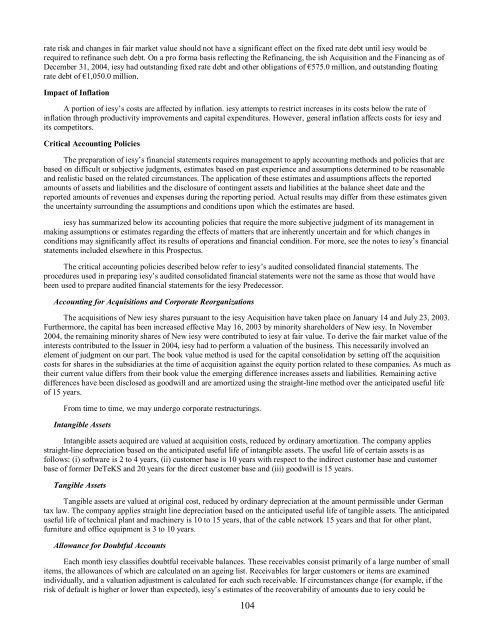iesy Repository GmbH - Irish Stock Exchange
iesy Repository GmbH - Irish Stock Exchange
iesy Repository GmbH - Irish Stock Exchange
Create successful ePaper yourself
Turn your PDF publications into a flip-book with our unique Google optimized e-Paper software.
ate risk and changes in fair market value should not have a significant effect on the fixed rate debt until <strong>iesy</strong> would be<br />
required to refinance such debt. On a pro forma basis reflecting the Refinancing, the ish Acquisition and the Financing as of<br />
December 31, 2004, <strong>iesy</strong> had outstanding fixed rate debt and other obligations of €575.0 million, and outstanding floating<br />
rate debt of €1,050.0 million.<br />
Impact of Inflation<br />
A portion of <strong>iesy</strong>’s costs are affected by inflation. <strong>iesy</strong> attempts to restrict increases in its costs below the rate of<br />
inflation through productivity improvements and capital expenditures. However, general inflation affects costs for <strong>iesy</strong> and<br />
its competitors.<br />
Critical Accounting Policies<br />
The preparation of <strong>iesy</strong>’s financial statements requires management to apply accounting methods and policies that are<br />
based on difficult or subjective judgments, estimates based on past experience and assumptions determined to be reasonable<br />
and realistic based on the related circumstances. The application of these estimates and assumptions affects the reported<br />
amounts of assets and liabilities and the disclosure of contingent assets and liabilities at the balance sheet date and the<br />
reported amounts of revenues and expenses during the reporting period. Actual results may differ from these estimates given<br />
the uncertainty surrounding the assumptions and conditions upon which the estimates are based.<br />
<strong>iesy</strong> has summarized below its accounting policies that require the more subjective judgment of its management in<br />
making assumptions or estimates regarding the effects of matters that are inherently uncertain and for which changes in<br />
conditions may significantly affect its results of operations and financial condition. For more, see the notes to <strong>iesy</strong>’s financial<br />
statements included elsewhere in this Prospectus.<br />
The critical accounting policies described below refer to <strong>iesy</strong>’s audited consolidated financial statements. The<br />
procedures used in preparing <strong>iesy</strong>’s audited consolidated financial statements were not the same as those that would have<br />
been used to prepare audited financial statements for the <strong>iesy</strong> Predecessor.<br />
Accounting for Acquisitions and Corporate Reorganizations<br />
The acquisitions of New <strong>iesy</strong> shares pursuant to the <strong>iesy</strong> Acquisition have taken place on January 14 and July 23, 2003.<br />
Furthermore, the capital has been increased effective May 16, 2003 by minority shareholders of New <strong>iesy</strong>. In November<br />
2004, the remaining minority shares of New <strong>iesy</strong> were contributed to <strong>iesy</strong> at fair value. To derive the fair market value of the<br />
interests contributed to the Issuer in 2004, <strong>iesy</strong> had to perform a valuation of the business. This necessarily involved an<br />
element of judgment on our part. The book value method is used for the capital consolidation by setting off the acquisition<br />
costs for shares in the subsidiaries at the time of acquisition against the equity portion related to these companies. As much as<br />
their current value differs from their book value the emerging difference increases assets and liabilities. Remaining active<br />
differences have been disclosed as goodwill and are amortized using the straight-line method over the anticipated useful life<br />
of 15 years.<br />
From time to time, we may undergo corporate restructurings.<br />
Intangible Assets<br />
Intangible assets acquired are valued at acquisition costs, reduced by ordinary amortization. The company applies<br />
straight-line depreciation based on the anticipated useful life of intangible assets. The useful life of certain assets is as<br />
follows: (i) software is 2 to 4 years, (ii) customer base is 10 years with respect to the indirect customer base and customer<br />
base of former DeTeKS and 20 years for the direct customer base and (iii) goodwill is 15 years.<br />
Tangible Assets<br />
Tangible assets are valued at original cost, reduced by ordinary depreciation at the amount permissible under German<br />
tax law. The company applies straight line depreciation based on the anticipated useful life of tangible assets. The anticipated<br />
useful life of technical plant and machinery is 10 to 15 years, that of the cable network 15 years and that for other plant,<br />
furniture and office equipment is 3 to 10 years.<br />
Allowance for Doubtful Accounts<br />
Each month <strong>iesy</strong> classifies doubtful receivable balances. These receivables consist primarily of a large number of small<br />
items, the allowances of which are calculated on an ageing list. Receivables for larger customers or items are examined<br />
individually, and a valuation adjustment is calculated for each such receivable. If circumstances change (for example, if the<br />
risk of default is higher or lower than expected), <strong>iesy</strong>’s estimates of the recoverability of amounts due to <strong>iesy</strong> could be<br />
104

















